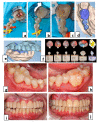From Child to Adulthood, a Multidisciplinary Approach of Multiple Microdontia Associated with Hypodontia: Case Report Relating a 15 Year-Long Management and Follow-Up
- PMID: 34574954
- PMCID: PMC8464950
- DOI: 10.3390/healthcare9091180
From Child to Adulthood, a Multidisciplinary Approach of Multiple Microdontia Associated with Hypodontia: Case Report Relating a 15 Year-Long Management and Follow-Up
Abstract
Oral rehabilitation of patients presenting multiple microdontia is a real therapeutic challenge. These alterations in size, often associated with other dental anomalies, have aesthetic and functional repercussions for patients and can lead to significant psycho-social consequences. We report here the case of an 11-year-old patient with bilateral sectorial microdontia and agenesis of teeth numbers 13 and 23. She also presented staturo-ponderal delay and a history of acute coronary syndrome with a lower coronary occlusion of unknown aetiology. At first, additive coronoplasties and an orthodontically retained interim prosthesis answered the aesthetic and functional need during childhood and adolescence. Once she reached adulthood, a multidisciplinary meeting was conducted and a treatment plan was established. The decision was made to rehabilitate the upper arch with a permanent bridge and the lower arch with indirect adhesive restorations. This solution solved the problem of the bilateral lateral infraocclusions and tooth agenesis, restoring both aesthetics and function. This paper presents 15 years of management and treatment of a patient presenting multiple microdontia associated with hypodontia. Both the multidisciplinary approach and coordination between the different medical team members was essential to maintain the existing dentition while preparing, planning, and carrying out a personalized treatment plan once maxillofacial growth was complete.
Keywords: hypodontia; microdontia; multidisciplinary treatment; oral rehabilitation; prosthetics.
Conflict of interest statement
The authors declare no conflict of interest.
Figures








Similar articles
-
A rare occurrence of nonsyndromic focal microdontia of primary teeth with hypodontia of permanent teeth in a pediatric patient.J Oral Maxillofac Pathol. 2022 Feb;26(Suppl 1):S22-S25. doi: 10.4103/jomfp.jomfp_62_21. Epub 2022 Feb 28. J Oral Maxillofac Pathol. 2022. PMID: 35450236 Free PMC article.
-
Comparison of mesiodistal crown dimension and arch width in subjects with and without hypodontia.J Esthet Restor Dent. 2013 Jun;25(3):203-10. doi: 10.1111/jerd.12026. Epub 2013 Apr 2. J Esthet Restor Dent. 2013. PMID: 23773516
-
Prevalence and distribution of dental anomalies: a comparison between maxillary and mandibular tooth agenesis.Am J Orthod Dentofacial Orthop. 2015 Nov;148(5):793-8. doi: 10.1016/j.ajodo.2015.05.024. Am J Orthod Dentofacial Orthop. 2015. PMID: 26522039
-
The dentition: the outcomes of morphogenesis leading to variations of tooth number, size and shape.Aust Dent J. 2014 Jun;59 Suppl 1:131-42. doi: 10.1111/adj.12160. Epub 2014 Mar 20. Aust Dent J. 2014. PMID: 24646162 Review.
-
Tooth agenesis: An overview of diagnosis, aetiology and management.Jpn Dent Sci Rev. 2023 Dec;59:209-218. doi: 10.1016/j.jdsr.2023.07.001. Epub 2023 Jul 7. Jpn Dent Sci Rev. 2023. PMID: 37645267 Free PMC article. Review.
Cited by
-
Personalized and Complex Esthetic Oral Rehabilitation in a Case of Non-Syndromic Oligodontia.J Pers Med. 2024 Mar 27;14(4):350. doi: 10.3390/jpm14040350. J Pers Med. 2024. PMID: 38672977 Free PMC article.
-
Pre-orthodontic restorative treatment of microdontia diastema teeth using composite injection technique with a digital workflow-Case report.Heliyon. 2023 Apr 28;9(5):e15843. doi: 10.1016/j.heliyon.2023.e15843. eCollection 2023 May. Heliyon. 2023. PMID: 37215809 Free PMC article.
References
-
- Villa A., Albonico A., Villa F. Hypodontia and microdontia: Clinical features of a rare syndrome. J. Can. Dent. Assoc. 2011;77:b115. - PubMed
Publication types
LinkOut - more resources
Full Text Sources

